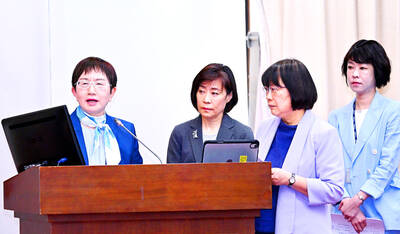The nation’s inflationary pressures subsided last month, with the consumer price gauge decelerating to a 17-month low of 1.21 percent, bringing the yearly inflation rate to 3.52 percent mainly on surging fuel and food costs last summer, the Directorate-General of Budget, Accounting and Statistics (DGBAS) said yesterday.
The downshifts are expected to persist this year, giving monetary authorities more room to cut interest rates to galvanize economic activity at home amid the global economic crisis, analysts said.
“The [seasonally adjusted] consumer price index gained 1.21 percent year-on-year in December, the smallest hike since August 2007,” DGBAS section chief Wu Chao-ming (吳昭明) said at a media briefing. “The measure declined 1.85 percent from a month earlier, owing to sustained drops in oil and raw material costs.”
The inflation rate stood at 3.52 percent last year, driven chiefly by soaring fuel and food prices in the first half, Wu said, adding that prices retreated drastically in the second half on falling demand amid the financial market turmoil.
The core consumer price index (CPI), which is used to track long-term inflation as the index excludes energy, fruit and vegetable prices, dipped 0.21 percent last month on falling prices across the board, the DGBAS report showed. The annual core CPI rose 3.07 percent, the highest since 1997.
Meanwhile, the wholesale price index plunged 9.11 percent from the previous year, but Wu said it would take six months for retailers to reflect the cost adjustments, if they do so at all.
Tony Phoo (符銘財), a Taipei-based economist at Standard Chartered Bank, said the easing inflationary pressures would give the central bank greater leeway to lower interest rates and boost private consumption.
“As oil and raw material prices are unlikely to pick up, the CPI is bound to remain low, giving the central bank a free hand to cut interest rates in fighting recession,” Phoo said by telephone.

‘SWASTICAR’: Tesla CEO Elon Musk’s close association with Donald Trump has prompted opponents to brand him a ‘Nazi’ and resulted in a dramatic drop in sales Demonstrators descended on Tesla Inc dealerships across the US, and in Europe and Canada on Saturday to protest company chief Elon Musk, who has amassed extraordinary power as a top adviser to US President Donald Trump. Waving signs with messages such as “Musk is stealing our money” and “Reclaim our country,” the protests largely took place peacefully following fiery episodes of vandalism on Tesla vehicles, dealerships and other facilities in recent weeks that US officials have denounced as terrorism. Hundreds rallied on Saturday outside the Tesla dealership in Manhattan. Some blasted Musk, the world’s richest man, while others demanded the shuttering of his

ADVERSARIES: The new list includes 11 entities in China and one in Taiwan, which is a local branch of Chinese cloud computing firm Inspur Group The US added dozens of entities to a trade blacklist on Tuesday, the US Department of Commerce said, in part to disrupt Beijing’s artificial intelligence (AI) and advanced computing capabilities. The action affects 80 entities from countries including China, the United Arab Emirates and Iran, with the commerce department citing their “activities contrary to US national security and foreign policy.” Those added to the “entity list” are restricted from obtaining US items and technologies without government authorization. “We will not allow adversaries to exploit American technology to bolster their own militaries and threaten American lives,” US Secretary of Commerce Howard Lutnick said. The entities

Taiwan’s official purchasing managers’ index (PMI) last month rose 0.2 percentage points to 54.2, in a second consecutive month of expansion, thanks to front-loading demand intended to avoid potential US tariff hikes, the Chung-Hua Institution for Economic Research (CIER, 中華經濟研究院) said yesterday. While short-term demand appeared robust, uncertainties rose due to US President Donald Trump’s unpredictable trade policy, CIER president Lien Hsien-ming (連賢明) told a news conference in Taipei. Taiwan’s economy this year would be characterized by high-level fluctuations and the volatility would be wilder than most expect, Lien said Demand for electronics, particularly semiconductors, continues to benefit from US technology giants’ effort

Minister of Finance Chuang Tsui-yun (莊翠雲) yesterday told lawmakers that she “would not speculate,” but a “response plan” has been prepared in case Taiwan is targeted by US President Donald Trump’s reciprocal tariffs, which are to be announced on Wednesday next week. The Trump administration, including US Secretary of the Treasury Scott Bessent, has said that much of the proposed reciprocal tariffs would focus on the 15 countries that have the highest trade surpluses with the US. Bessent has referred to those countries as the “dirty 15,” but has not named them. Last year, Taiwan’s US$73.9 billion trade surplus with the US